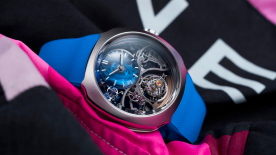Why did you make the switch from politics to motorsport?
Well, I didn’t make the switch directly. I was unemployed for a while and I took some holidays because I got married. When I got married there was a conflict of interest, because my wife’s father was the prime minister of the country and also my boss. So I had to choose between my political career and marrying my wife, and I chose my wife. It was a very good decision! I had some friends in motorsport, Bernie Ecclestone and Flavio Briatore, who encouraged me to start working in the field, so I started working with them.
When you started Formula E did you already sense the shift towards electric vehicles?
No. I was hoping for it but six years ago it wasn’t so obvious at all. That’s why I was able to do it, otherwise someone else who was bigger than me would have done it. I did something that nobody else was looking at. I was really lucky because then the entire car industry started shifting towards electric, which was really good for us.
How has the championship developed?
In my original business plan I said that by year five we would have three manufacturers competing in the championship. We are now in year four and we have nine, so we are far beyond where we thought we would be. And we have great sponsors who supported us from the start. This was not easy because there was a lot of scepticism at the outset because people thought we were going to fail and as a result they did not want to be associated with us.
How much does the street racing contribute to the success of Formula E?
Very much. We needed to do something very different from everyone else, otherwise we wouldn’t have any chance of success. We positioned the championship as clean and innovative and racing in cities was a key part of our differentiation. By 2050 80% of the world’s population will be living in cities and the future of urban living and smart cities are hot topics. It’s very difficult to race in cities because you need to use existing roads and set up the circuit very quickly.
How has the technology evolved over the six years of the championship?
The evolution has been huge. In the first years each driver had two cars and would change during the race because the battery capacity wasn’t enough to last the entire race. As of this season, the car we have presented at the Geneva International Motor Show will be able to do the entire race. So we have doubled the autonomy of the car in six years, which is huge.
How much feedback do you get through the fan boost?
We are getting really good data from our research into social media activity, especially as far as the younger generation is concerned. Our audience is really growing in the 12-18 years age category, which is a great demographic to capture. We also see that they only consume on mobile and they very rarely consume live. They watch the races when they want to.
How do see the future of the championship?
I think it will continue to grow. The internal combustion engine has been at the peak of its development for a number of years already but we have already progressed by 100% in a few years, so there is still great potential. In time it will be the only motorsport that is relevant to the car industry as it migrates ever more to electric technology. Other motorsport events will become increasingly like vintage sports because they will no longer be related to the cars that are being sold.







